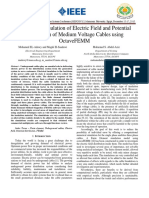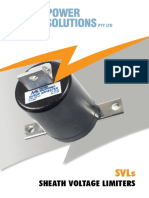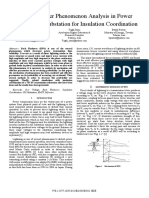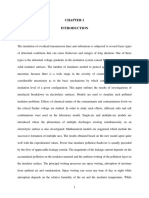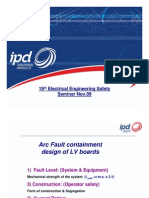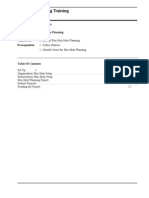Insulation Strength Characteristics
Uploaded by
sorry2qazInsulation Strength Characteristics
Uploaded by
sorry2qazProcedure for Insulation Coordination in Four Steps
Flow chart acc. to IEC 60071-1 (Figure 1)
[IEC 60071-1]
Fachgebiet Hochspannungstechnik
Overvoltage Protection and Insulation Coordination / Chapter 6
-1-
Procedure for Insulation Coordination in Four Steps
Determination of the coordination withstand voltages Ucw The coordination withstand voltages are the lowest values of withstand voltages of each overvoltage class, for which the expected low failure rate of the equipment is not exceeded over its full lifetime. Derived from the representative overvoltages Urp by the coordination factor Kc.
Typical for Germany: 0.1% per year 1 failure in 1000 years
[IEC 60071-1]
Fachgebiet Hochspannungstechnik
Overvoltage Protection and Insulation Coordination / Chapter 6
-2-
Insulation Strength Characteristics
Factors influencing the dielectric strength of the insulation: Factors influencing the dielectric strength of the insulation:
magnitude, shape, duration and polarity of the applied voltage magnitude, shape, duration and polarity of the applied voltage electric field distribution in the insulation electric field distribution in the insulation homogeneous or non-homogeneous electric field homogeneous or non-homogeneous electric field electrodes adjacent to the considered gap and their potential electrodes adjacent to the considered gap and their potential type of insulation type of insulation gaseous gaseous liquid liquid solid solid combination of two or all of them combination of two or all of them impurity content and the presence of local inhomogeneities impurity content and the presence of local inhomogeneities physical state of the insulation physical state of the insulation temperature temperature pressure pressure other ambient conditions other ambient conditions mechanical stress mechanical stress history of the insulation (aging, damage) history of the insulation (aging, damage) chemical effects chemical effects conductor surface effects conductor surface effects
Fachgebiet Hochspannungstechnik
Overvoltage Protection and Insulation Coordination / Chapter 6
-3-
Insulation Strength Characteristics
Standard atmospheric conditions acc. to IEC 60060-1
Temperature: Pressure: Absolute humidity:
20 C 1013 hPa 3 11 g/m3
Fachgebiet Hochspannungstechnik
Overvoltage Protection and Insulation Coordination / Chapter 6
-4-
Insulation Strength Characteristics
Topics to be covered in the following: Insulators under polluted conditions Probability of flashover (Normal and Weibull distributions) Behavior of parallel insulation Coordination procedure: deterministic and statistical approach Correction with altitude of installation Clearances in air; "gap factors"
Fachgebiet Hochspannungstechnik
Overvoltage Protection and Insulation Coordination / Chapter 6
-5-
Performance of Insulators under Pollution
Pre-conditions Pre-conditions
Surface layers dust dust carbon black carbon black salt (coastal areas) salt (coastal areas) chemicals (industry, rural areas: fertilizers) chemicals (industry, rural areas: fertilizers) no problem in dry condition after long rain periods: only moderate effect on flashover performance most critical: Humidification after a long dry period Humidification after a long dry period typical time of the day for insulator flashovers: morning hours (dew!)
Fachgebiet Hochspannungstechnik
Overvoltage Protection and Insulation Coordination / Chapter 6
-6-
Performance of Insulators under Pollution
Development of pollution flashover Development of pollution flashover
dry zone by inhomogeneity of the layer enlargement of the dry zone by heating of the zone edges (increased current density)
dry band
flashover of the dry band
enlargement of the dry band by arc heating (max. temperature at foot points)
Fachgebiet Hochspannungstechnik
Overvoltage Protection and Insulation Coordination / Chapter 6
-7-
Performance of Insulators under Pollution
Development of pollution flashover Development of pollution flashover
a) with dry bands b) dry bands bridged by partial arcs
voltage drop increased voltage bridged
Voltage distribution for further details see HVT 2!
Fachgebiet Hochspannungstechnik
Overvoltage Protection and Insulation Coordination / Chapter 6
-8-
Performance of Insulators under Pollution
Influence of layer conductivity Influence of layer conductivity
for details see IEC 60507
Layer conductivity K is the most important parameter! Layer conductivity K is the most important parameter! K = ds
... specific layer conductivity
ds ... thickness of layer
K = 5 S K = 10 S K = 40 S
"light to medium pollution" "medium to heavy pollution" "very heavy pollution"
Fachgebiet Hochspannungstechnik
Overvoltage Protection and Insulation Coordination / Chapter 6
-9-
Performance of Insulators under Pollution
Determination of layer conductivity from Determination of layer conductivity from measured conductance and insulator geometry measured conductance and insulator geometry
shed core creepage distance lk
Measurement of conductance G of the full insulator
insulator length l
general:
G=
V
l
2 r d s K dG = = dl d l / 2 r
Fachgebiet Hochspannungstechnik
Overvoltage Protection and Insulation Coordination / Chapter 6
- 10 -
Performance of Insulators under Pollution
Determination of layer conductivity from Determination of layer conductivity from measured conductance and insulator geometry measured conductance and insulator geometry
G=
K
lk
dl 2 r 0
G ... conductance of total insulator surface
dl F = 2 r 0
K = FG K = FG
lk
form factor" form factor"
(IEC 60507*)) form factor to be determined by graphical procedure, described in IEC 60507
*) IEC 60507, 2nd Ed. 1991-04: "Artificial pollution tests on high-voltage insulators to be used on a.c. systems"
Fachgebiet Hochspannungstechnik
Overvoltage Protection and Insulation Coordination / Chapter 6
- 11 -
Performance of Insulators under Pollution
Decrease in flashover voltage by conductive layers Decrease in flashover voltage by conductive layers
fo, rain 0.7 ... 0.9 fo, dry Ufo, polluted 0.2 ... 0.3 Ufo,dry
An overhead line insulator must be desigend about five times as long as An overhead line insulator must be desigend about five times as long as required to withstand operating stresses under dry conditions! required to withstand operating stresses under dry conditions!
Um = 123 kV L-E = 100 kV d = 5 kV/cm l = 20 cm would be sufficient (dry!)
Actual length: ca. 1100 mm
Fachgebiet Hochspannungstechnik
Overvoltage Protection and Insulation Coordination / Chapter 6
- 12 -
Performance of Insulators under Pollution
Countermeasures Countermeasures
p
Sheds Sheds Terms ... s ... flashover or arcing distance lk ... creepage distance li ... insulator length p ... shed overhang t ... shed spacing
Fachgebiet Hochspannungstechnik
Overvoltage Protection and Insulation Coordination / Chapter 6
- 13 -
Performance of Insulators under Pollution
Countermeasures Countermeasures
p
Reference value is Um, ,i.e. Reference value is Um i.e. the phase to-phase-voltage! the phase to-phase-voltage! li derived from required standard lightning impulse voltage strength (ud, LI ca. 5.5 kV/cm) lk from requirement on specific creepage distance (IEC 60815*))
Note: IEC 60815 applicable to porcelain insulators; so far no standard on polymeric insulators available
= 20%
31 mm/kV 31 mm/kV 25 mm/kV 25 mm/kV 20 mm/kV 20 mm/kV 16 mm/kV 16 mm/kV
for very heavy" pollution severity (IV) for very heavy" pollution severity (IV) for heavy" pollution severity (III) for heavy" pollution severity (III) for "medium" pollution severity (II) for "medium" pollution severity (II) for "light" pollution severity (I) for "light" pollution severity (I)
*) IEC 60815, 1st Ed. 1986: "Guide for the selection of insulators in respect of polluted conditions"
Fachgebiet Hochspannungstechnik
Overvoltage Protection and Insulation Coordination / Chapter 6
- 14 -
Performance of Insulators under Pollution
Countermeasures Countermeasures
31 mm/kV 31 mm/kV 25 mm/kV 25 mm/kV 20 mm/kV 20 mm/kV 16 mm/kV 16 mm/kV for very heavy" pollution severity (IV) for very heavy" pollution severity (IV) for heavy" pollution severity (III) for heavy" pollution severity (III) for "medium" pollution severity (II) for "medium" pollution severity (II) for "light" pollution severity (I) for "light" pollution severity (I)
Correction of these values necessary depending on insulator's average diameter Dm *) Correction factor kD (derived from service experience):
Dm (mm) < 300 300 - 500 > 500
kD 1 1.1 1.2
Pollution performance gets worse with increasing diameter!
*) for definition of Dm see IEC 60815
Fachgebiet Hochspannungstechnik
Overvoltage Protection and Insulation Coordination / Chapter 6
- 15 -
Performance of Insulators under Pollution
Fachgebiet Hochspannungstechnik
Overvoltage Protection and Insulation Coordination / Chapter 6
- 16 -
Performance of Insulators under Pollution
IEC 60815, Table 1 IEC 60815, Table 1
Pollution level Examples of typical environments - Areas without industries and with low density of houses equipped with heating plants - Areas with low density of industries or houses but subjected to frequent winds and/or rainfall - Agricultural areas 1) - Mountainous areas All these areas shall be situated at least 10 km to 20 km from the sea and shall not be exposed to winds directly from the sea 2) - Areas with industries not producing particularly polluting smoke and/or with average density of houses equipped with heating plants - Areas with high density of houses and/or industries but subjected to frequent winds and/or rainfall - Areas exposed to wind from the sea but not too close to the coast (at least several kilometres distant) 2) - Areas with high density of industries and suburbs of large cities with high density of heating plants producing pollution - Areas close to the sea or in any case exposed to relatively strong winds from the sea 2) - Areas generally of moderate extent, subjected to conductive dusts and to industrial smoke producing particularly thick conductive deposits - Areas generally of moderate extent, very close to the coast and exposed to sea-spray or to very strong and polluting winds from the sea - Desert areas, characterized by no rain for long periods, exposed to strong winds carrying sand and salt, and subjected to regular condensation
I - Light
II - Medium
III - Heavy
IV - Very heavy
1) Use of fertilizers by spraying, or the burning of crop residues, can lead to a higher pollution level due to dispersal by wind. 2) Distances from sea coast depend on the topography of the coastal area and on the extreme wind conditions.
Fachgebiet Hochspannungstechnik
Overvoltage Protection and Insulation Coordination / Chapter 6
- 17 -
Performance of Insulators under Pollution
Shed profiles Shed profiles
IEC 60815
Some typical shed profiles (from IEC 60815; explanation of the parameters see there). Some typical shed profiles (from IEC 60815; explanation of the parameters see there). From left to right: normal shed profile, alternating shed profile, underrib sheds (fog profile), From left to right: normal shed profile, alternating shed profile, underrib sheds (fog profile), cap-and-pin insulators cap-and-pin insulators
Fachgebiet Hochspannungstechnik
Overvoltage Protection and Insulation Coordination / Chapter 6
- 18 -
Performance of Insulators under Pollution
Shed profiles Shed profiles
c 30 mm p1 p2 15 mm s/p1 0.65 (in case of plain, non-underripped sheds) lx/dx < 5 C.F. 3.5 (pollution classes I + II) 4 (pollution classes III + IV)
C.F.= creepage factor = lt/st lt = total creepage distance st = arcing distance (arcing horns not considered)
Recommendations of IEC 60815 - Example
IEC 60815
Fachgebiet Hochspannungstechnik
Overvoltage Protection and Insulation Coordination / Chapter 6
- 19 -
Performance of Insulators under Pollution
Shed profiles Shed profiles
Recommendations of IEC 60815 - Example
5 specified No specification for bottom side angle; however, 2 "advisable" in case of sheds without underribs
IEC 60815
Fachgebiet Hochspannungstechnik
Overvoltage Protection and Insulation Coordination / Chapter 6
- 20 -
Performance of Insulators under Pollution
Shed profiles Shed profiles
Example of user's experience
From: Raouf Znaidi: "Service Experience and Maintenance Requirements for Different Types of Insulators in Tunisia", World Congress on Insulators, Arresters and Bushings, Hong Kong, Nov. 27-30, 2005
Fachgebiet Hochspannungstechnik
Overvoltage Protection and Insulation Coordination / Chapter 6
- 21 -
Performance of Insulators under Pollution
Cleaning, greasing, coating of insulators Cleaning, greasing, coating of insulators
Some particular sites require regular cleaning of the insulators. Extreme situation: Extreme situation: Maritime desert climate with industrial pollution Maritime desert climate with industrial pollution (e.g.: petrochemical facilities in Saudi-Arabia) (e.g.: petrochemical facilities in Saudi-Arabia) But also in Middle Europe in the vicinity of industrial facilities (steel works, petrochemistry)
for further details see HVT 2!
Fachgebiet Hochspannungstechnik
Overvoltage Protection and Insulation Coordination / Chapter 6
- 22 -
Performance of Insulators under Pollution
Semi-conducting glazing Semi-conducting glazing
Idea: to avoid dry-band arcing by resistive bypass
surface current Drawback: stable semiconducting glazing difficult to produce
No flashover due to bypass current
Fachgebiet Hochspannungstechnik
Overvoltage Protection and Insulation Coordination / Chapter 6
- 23 -
Performance of Insulators under Pollution
Semi-conducting glazing Semi-conducting glazing
Under development: for composite insulators by coating filled with micro-varistors
-varistors
Fachgebiet Hochspannungstechnik
Overvoltage Protection and Insulation Coordination / Chapter 6
- 24 -
Performance of Insulators under Pollution
Composite insulators Composite insulators
FRP core extruded SIR sheath
Shed material: EPDM (Ethylene-PropyleneDiene-Monomer) only in distribution Silicone rubber (SIR)
crimped-on metal end fitting push-over SIR sheds
introduced in the beginning of the 1970s today virtually" state of the art problems": long time performance not yet clear, "brittle fracture", animal attacks
Fachgebiet Hochspannungstechnik
Overvoltage Protection and Insulation Coordination / Chapter 6
- 25 -
From an EPRI Questionnaire in North America (publ. in 2003)
Fachgebiet Hochspannungstechnik
Overvoltage Protection and Insulation Coordination / Chapter 6
- 26 -
From an EPRI Questionnaire in North America (publ. in 2003)
Fachgebiet Hochspannungstechnik
Overvoltage Protection and Insulation Coordination / Chapter 6
- 27 -
From an EPRI Questionnaire in North America (publ. in 2003)
compare this with the "bathtub curve"of failure no evidence for aging
Fachgebiet Hochspannungstechnik
Overvoltage Protection and Insulation Coordination / Chapter 6
- 28 -
From an EPRI Questionnaire in North America (publ. in 2003)
Fachgebiet Hochspannungstechnik
Overvoltage Protection and Insulation Coordination / Chapter 6
- 29 -
From an EPRI Questionnaire in North America (publ. in 2003)
Fachgebiet Hochspannungstechnik
Overvoltage Protection and Insulation Coordination / Chapter 6
- 30 -
Performance of Insulators under Pollution
Hydrophobicity Hydrophobicity
One of the most important properties of composite insulators with regard to pollution performance is Hydrophobicity Hydrophobicity
Fachgebiet Hochspannungstechnik
Overvoltage Protection and Insulation Coordination / Chapter 6
- 31 -
Performance of Insulators under Pollution
Hydrophobicity Hydrophobicity
Receding angle Receding angle = most important for characterization = most important for characterization of hydrophobicity of hydrophobicity
Advancing angle
Properties change under the influence of electrical field
actual research!
Fachgebiet Hochspannungstechnik
Overvoltage Protection and Insulation Coordination / Chapter 6
- 32 -
Performance of Insulators under Pollution
Hydrophobicity Hydrophobicity
Draft IEC 62073 Hydrophobicity classes*)
*) Based on the "STRI Guide" (of STRI, Ludvika/Sweden)
Fachgebiet Hochspannungstechnik
Overvoltage Protection and Insulation Coordination / Chapter 6
- 33 -
Performance of Insulators under Pollution
Silicone rubber as insulator material Silicone rubber as insulator material
Hydrophobicity only with silicone rubber Hydrophobicity only with silicone rubber Hydrophobicity transfer to pollution layers Hydrophobicity transfer to pollution layers Dynamics of hydrophobicity Dynamics of hydrophobicity Excellent tracking resistance Excellent tracking resistance
Excellent service record so far (only few exceptions where silicone rubber is not optimal, Excellent service record so far (only few exceptions where silicone rubber is not optimal, e.g. under extreme coastal conditions, i.e. heavy salt layers) e.g. under extreme coastal conditions, i.e. heavy salt layers)
Fachgebiet Hochspannungstechnik
Overvoltage Protection and Insulation Coordination / Chapter 6
- 34 -
Weather Aging Tests for Polymeric Insulators
Natural Test Sites Natural Test Sites
Realistic test conditions, but no acceleration factors long test times necessary (several years) "(In)famous" test sites: Koeburg, RSA (Atlantic Ocean) Dungeness, UK (The Channel) Martiguez, F (Mediterranean Sea)
*)
*) NOTE: often the term NCI = non ceramic insulators is being used
Example: Koeburg, RSA
Fachgebiet Hochspannungstechnik
Overvoltage Protection and Insulation Coordination / Chapter 6
- 35 -
Weather Aging Tests for Polymeric Insulators
Natural Test Sites Natural Test Sites
Example: Dungeness, UK (Excursion 2002)
Fachgebiet Hochspannungstechnik
Overvoltage Protection and Insulation Coordination / Chapter 6
- 36 -
Weather Aging Tests for Polymeric Insulators
The "Tracking and Erosion Test" acc. to IEC 61109 The "Tracking and Erosion Test" acc. to IEC 61109
Similar test procedures specified e.g. for surge arresters (IEC 60099-4) and for polymeric insulators (IEC document 36/213/CDV: Project IEC 62217)
Fachgebiet Hochspannungstechnik
Overvoltage Protection and Insulation Coordination / Chapter 6
- 37 -
Weather Aging Tests for Polymeric Insulators
The "Tracking and Erosion Test" acc. to IEC 61109 The "Tracking and Erosion Test" acc. to IEC 61109
Examples of test chambers
Fachgebiet Hochspannungstechnik
Overvoltage Protection and Insulation Coordination / Chapter 6
- 38 -
Weather Aging Tests for Polymeric Insulators
The "Tracking and Erosion Test" acc. to IEC 61109 The "Tracking and Erosion Test" acc. to IEC 61109
Tracking Erosion
Fachgebiet Hochspannungstechnik
Overvoltage Protection and Insulation Coordination / Chapter 6
- 39 -
Weather Aging Tests for Polymeric Insulators
Cyclic Tests Cyclic Tests
Cyclic tests usually consist in applying, in addition to voltage stress, various stresses in a cyclic manner: - solar radiation simulation; - artificial rain; - dry heat; - damp heat (near saturation); - high dampness at room temperature (saturation has to be obtained); - salt fog at low concentration. Furthermore, temperature variations may cause some degree of mechanical stress, especially at the level of insulator interfaces and also give rise to condensation phenomena, which are repeated several times in the course of a cycle. For power frequency test voltage, a test transformer shall be used. The test circuit when loaded with a resistive current of 250 mA (r.m.s.) on the high voltage side shall experience a maximum voltage drop of 5 %. The protection level shall be set at 1 A (r.m.s.). Problem: no general agreement on one particular test! Problem: no general agreement on one particular test!
Fachgebiet Hochspannungstechnik
Examples next slides:
- 40 -
Overvoltage Protection and Insulation Coordination / Chapter 6
Weather Aging Tests for Polymeric Insulators
Cyclic Tests Cyclic Tests
Practical test problem: rain and solar radiation at the same time!
Fachgebiet Hochspannungstechnik
Overvoltage Protection and Insulation Coordination / Chapter 6
- 41 -
Weather Aging Tests for Polymeric Insulators
Cyclic Tests Cyclic Tests
Fachgebiet Hochspannungstechnik
Overvoltage Protection and Insulation Coordination / Chapter 6
- 42 -
Weather Aging Tests for Polymeric Insulators
Cyclic Tests Cyclic Tests
"EPRI" cycle: a year in service is considered to be represented by 10 days of summer cycle and 11 days of winter cycle. A duration of 5040 h is required for the whole test, 10 summer/winter cycles of 21 days each.
Fachgebiet Hochspannungstechnik
Overvoltage Protection and Insulation Coordination / Chapter 6
- 43 -
Other Aging Tests for Polymeric Insulators
Wheel Test acc. to IEC 62217 Wheel Test acc. to IEC 62217
Extremely severe test!
The test specimens shall be cleaned with de-ionized water before starting the test. The test specimens are mounted on the wheel as shown in Figure A.1 below. They go through four positions in one cycle. Each test specimen remains stationary for about 40 s in each of the four positions. The 90 rotation from one position to the next takes about 8 s. In the first part of the cycle the insulator is dipped into a saline solution. The second part of the test cycle permits the excess saline solution to drip off the specimen ensuring that the light wetting of the surface gives rise to sparking across dry bands that will form during the third part of the cycle. In that part the specimen is submitted to a power frequency voltage. In the last part of the cycle the surface of the specimen that had been heated by the dry band sparking is allowed to cool.
Electrical stress: NaCl content of de-ionized water: Ambient temperature: Test duration: The power frequency test voltage in kV is determined by dividing the actual creepage distance in millimetres by 28,6. 1,40 kg/m 0,06 kg/m 20 5 K C 30 000 cycles
The test is regarded as passed, if on both test specimens: no tracking occurs for composite insulators: erosion depth is less than 3 mm and does not reach the core; if applicable for resin insulators: erosion depth is less than 3 mm; no shed, housing or interface is punctured.
Fachgebiet Hochspannungstechnik
Overvoltage Protection and Insulation Coordination / Chapter 6
- 44 -
Other Aging Tests for Polymeric Insulators
Wheel Test Wheel Test
Fachgebiet Hochspannungstechnik
Overvoltage Protection and Insulation Coordination / Chapter 6
- 45 -
Performance of Insulators under Pollution
"Silicone Bonus" "Silicone Bonus"
For NCIs with permanent (recovering) hydrophobic characteristics a "silicone bonus" may be applied as a reduction factor of creepage distance (C.D.) compared with ceramic insulators:
Class 1 : : 70 % 75 % of C.D. of ceramic insulators Class 1 70 % 75 % of C.D. of ceramic insulators Class 2 : : 80 % of C.D. of ceramic insulators (not applicable in coastal areas!) Class 2 80 % of C.D. of ceramic insulators (not applicable in coastal areas!) Class 3 : : same C.D. as for ceramic insulators Class 3 same C.D. as for ceramic insulators Class 4 : : in general, application of NCI should be carefully checked for each Class 4 in general, application of NCI should be carefully checked for each individual application individual application
Fachgebiet Hochspannungstechnik
Overvoltage Protection and Insulation Coordination / Chapter 6
- 46 -
Performance of Polymeric Insulators
Silicone rubber as insulator material Silicone rubber as insulator material
Other problems ....
Moss, algea
Fachgebiet Hochspannungstechnik
Overvoltage Protection and Insulation Coordination / Chapter 6
- 47 -
Performance of Polymeric Insulators
Silicone rubber as insulator material Silicone rubber as insulator material
Other problems .... Animal attack (parrots, cockattoos, termites) Example: Australia Example: Australia
Fachgebiet Hochspannungstechnik
Overvoltage Protection and Insulation Coordination / Chapter 6
- 48 -
Performance of Polymeric Insulators
Silicone rubber as insulator material Silicone rubber as insulator material
Other problems .... Animal attack (parrots, cockattoos, termites) Example: Australia Example: Australia
Fachgebiet Hochspannungstechnik
Overvoltage Protection and Insulation Coordination / Chapter 6
- 49 -
Performance of Polymeric Insulators
Brittle fracture Brittle fracture
Countermeasures: ECR glass (electro-chemical resistant) quality of sealing at triple point field stress reduction by grading rings
From: M. Kuhl: "FRP Rods for Brittle Fracture Resistant Composite Insulators", http://www.lappinsulator.com/downloadcenter/technical.asp Fachgebiet Hochspannungstechnik
Overvoltage Protection and Insulation Coordination / Chapter 6
- 50 -
Performance of Insulators under Pollution
Artificial pollution tests Artificial pollution tests
IEC standard 60507 IEC standard 60507 2 different methods: Salt fog method Salt fog method Solid layer method Solid layer method
Fachgebiet Hochspannungstechnik
Overvoltage Protection and Insulation Coordination / Chapter 6
- 51 -
Performance of Insulators under Pollution
Salt fog method Salt fog method
Test specimen energized at operating voltage under conductive salt fog exposure Test specimen energized at operating voltage under conductive salt fog exposure Salt mass concentration between 2.5 kg/m33und 224 kg/m33 Salt mass concentration between 2.5 kg/m und 224 kg/m (1 kg/m3 corresponds to 1 g/l) Test specimen must not flash over within a specified time of exposure Test specimen must not flash over within a specified time of exposure Classification by withstand salt mass concentration Classification by withstand salt mass concentration
Fachgebiet Hochspannungstechnik
Overvoltage Protection and Insulation Coordination / Chapter 6
- 52 -
Performance of Insulators under Pollution
Solid layer method Solid layer method
Solid layer of specified conductivity is applied in wet condition and dried Solid layer of specified conductivity is applied in wet condition and dried Layer conductivity between 3 S and 80 S Layer conductivity between 3 S and 80 S Salt Deposit Density (SDD) between 0.03 mg/cm22and 0.60 mg/cm22 Salt Deposit Density (SDD) between 0.03 mg/cm and 0.60 mg/cm Test specimen is energized in a cold Test specimen is energized in a cold fog chamber and then exposed to fog chamber and then exposed to humidity humidity Test specimen is exposed to Test specimen is exposed to humidity in a cold fog chamber humidity in a cold fog chamber and then energized and then energized
Test specimen must not flash over within a specified time of exposure Test specimen must not flash over within a specified time of exposure Classification by withstand layer conductivity or withstand salt deposit density Classification by withstand layer conductivity or withstand salt deposit density
Fachgebiet Hochspannungstechnik
Overvoltage Protection and Insulation Coordination / Chapter 6
- 53 -
Performance of Insulators under Pollution
Artificial pollution tests Artificial pollution tests
Correlation between pollution level, recommended creepage distance and artificial pollution test parameters:
Fachgebiet Hochspannungstechnik
Overvoltage Protection and Insulation Coordination / Chapter 6
- 54 -
Performance of Insulators under Pollution
Radial Field Stress under Pollution Radial Field Stress under Pollution
Arises if there is an internal active part with a given, constant axial voltage distribution; risk of internal PD in case of internal gas volume puncture in case of pure solid insulation
MO-Scheiben MO discs
MO column Gas or solid Solid Conductive layer
Uaxial, int Uradial
Photo: PD in a porcelain housed surge arrester
- 55 -
Porzellangehuse-Innenwand porcelain housing, inner wall
Fachgebiet Hochspannungstechnik
Overvoltage Protection and Insulation Coordination / Chapter 6
Performance of Insulators under Pollution
Dielectric and Thermal Effects Dielectric and Thermal Effects
Example: 800-kV surge arrester
Outer surface discharges Outer surface discharges Internal partial Internal partial discharges discharges changes in internal changes in internal atmosphere atmosphere risk of deterioration risk of deterioration of all internal parts of all internal parts Risk of partial heating of Risk of partial heating of internal active elements internal active elements
Risk of external flashovers Risk of external flashovers
Risk of partial Risk of partial heating of internal heating of internal active elements active elements
Fachgebiet Hochspannungstechnik
Overvoltage Protection and Insulation Coordination / Chapter 6
- 56 -
Emerging Insulator Standards
From: Claude de Tourreil: "New IEC standards: their Impact on future Selection of Composite Insulators", World Congress on Insulators, Arresters and Bushings, Hong Kong, Nov. 2730, 2005 Fachgebiet Hochspannungstechnik
Overvoltage Protection and Insulation Coordination / Chapter 6
- 57 -
You might also like
- EG 0 Power System Earthing Guide For Website100% (10)EG 0 Power System Earthing Guide For Website120 pages
- CIGRE Guide For Transformer Fire Safety Practices88% (8)CIGRE Guide For Transformer Fire Safety Practices139 pages
- Electrical Installation Design Guide Calculations For Electricians and Designers 2nd Edition PDFNo ratings yetElectrical Installation Design Guide Calculations For Electricians and Designers 2nd Edition PDF97 pages
- Application of Matrix Methods To The Solution of Travelling-Wave Phenomena in Polyphase SystemsNo ratings yetApplication of Matrix Methods To The Solution of Travelling-Wave Phenomena in Polyphase Systems13 pages
- ANSI STD C57.120-1991 (IEEE Loss Evaluation Guide For100% (1)ANSI STD C57.120-1991 (IEEE Loss Evaluation Guide For28 pages
- Analysis of Short-Circuit Asymmetrical Currents in Power Distribution SystemsNo ratings yetAnalysis of Short-Circuit Asymmetrical Currents in Power Distribution Systems6 pages
- Electromagnetic Transient in Power System and Insulation Coordination Studies PDFNo ratings yetElectromagnetic Transient in Power System and Insulation Coordination Studies PDF210 pages
- Propagation of Transmission Level Switching Overvoltages PDFNo ratings yetPropagation of Transmission Level Switching Overvoltages PDF193 pages
- Electric Field and Voltage Distribution Along Non-Ceramic Insulators PDFNo ratings yetElectric Field and Voltage Distribution Along Non-Ceramic Insulators PDF16 pages
- Failure of The Collection Volume MethodNo ratings yetFailure of The Collection Volume Method10 pages
- Analysis of Induced Voltages and Power L 2No ratings yetAnalysis of Induced Voltages and Power L 213 pages
- ELECTABTech81025rHVDrAP - Protection of Transmission Lines Lecture-6 PDFNo ratings yetELECTABTech81025rHVDrAP - Protection of Transmission Lines Lecture-6 PDF5 pages
- A Simple Simulation Model For Analyzing Very Fast Transient Overvoltage in Gas Insulated SwitchgearNo ratings yetA Simple Simulation Model For Analyzing Very Fast Transient Overvoltage in Gas Insulated Switchgear6 pages
- Tower Modeling For Lightning Analysis of Overhead Transmission LinesNo ratings yetTower Modeling For Lightning Analysis of Overhead Transmission Lines6 pages
- Identification of Problems When Using Long High VoNo ratings yetIdentification of Problems When Using Long High Vo8 pages
- Summary of Insulation Coordination StandardNo ratings yetSummary of Insulation Coordination Standard7 pages
- Controlled Switching Technique For Minimization of Switching Surge ScienceNo ratings yetControlled Switching Technique For Minimization of Switching Surge Science13 pages
- Transformer Tap Setting in Optimal Load FlowNo ratings yetTransformer Tap Setting in Optimal Load Flow7 pages
- Modeling of WPP For Short Circuit AnalysisNo ratings yetModeling of WPP For Short Circuit Analysis7 pages
- Modeling Guidelines For Fast Front TransientsNo ratings yetModeling Guidelines For Fast Front Transients14 pages
- Simulation of Transients in Unerground Cables With Frequency Dependent Modal100% (1)Simulation of Transients in Unerground Cables With Frequency Dependent Modal12 pages
- Analysis of Very Fast Transients in Layer-Type Transformer WindingsNo ratings yetAnalysis of Very Fast Transients in Layer-Type Transformer Windings10 pages
- The Electromagnetic Theory of Coaxial Transmission Lines and Cylindrical ShieldsNo ratings yetThe Electromagnetic Theory of Coaxial Transmission Lines and Cylindrical Shields48 pages
- Surge Arrester Application of Mv-Capacitor BanksNo ratings yetSurge Arrester Application of Mv-Capacitor Banks4 pages
- Coordinación de Aislamiento en Líneas Aéreas de TransmisiónNo ratings yetCoordinación de Aislamiento en Líneas Aéreas de Transmisión473 pages
- Some Aspects of System Modelling For The Estimation of Lightning Performance of High Voltage SubstationsNo ratings yetSome Aspects of System Modelling For The Estimation of Lightning Performance of High Voltage Substations6 pages
- Modeling The Critical Flashover Voltage of High Voltage Insulators Using Artificial IntelligenceNo ratings yetModeling The Critical Flashover Voltage of High Voltage Insulators Using Artificial Intelligence18 pages
- Calculation Verification Distance Protection Settings Line Impedance Measurements Paper Luxenburger ENUNo ratings yetCalculation Verification Distance Protection Settings Line Impedance Measurements Paper Luxenburger ENU10 pages
- Back Flashover Phenomenon Analysis in Power Transmission Substation For Insulation CoordinationNo ratings yetBack Flashover Phenomenon Analysis in Power Transmission Substation For Insulation Coordination5 pages
- Points To Consider Regarding The Insulation Coordination of GIS Substations With Cable Connections To Overhead LinesNo ratings yetPoints To Consider Regarding The Insulation Coordination of GIS Substations With Cable Connections To Overhead Lines5 pages
- Impulse Efficiency of Grounding Electrodes: Effect of Frequency-Dependent Soil ParametersNo ratings yetImpulse Efficiency of Grounding Electrodes: Effect of Frequency-Dependent Soil Parameters8 pages
- Flashover Influence of Fog Rate On The Characteristics of Polluted Silicone Rubber InsulatorsNo ratings yetFlashover Influence of Fog Rate On The Characteristics of Polluted Silicone Rubber Insulators5 pages
- Reference Material I 24-08-2021 Exp 3 Insulation ResistanceNo ratings yetReference Material I 24-08-2021 Exp 3 Insulation Resistance10 pages
- Sobretensiones y Coordinacione de AislamientoNo ratings yetSobretensiones y Coordinacione de Aislamiento280 pages
- Effect of Arc Current On Properties of Composite Insulators For Overhead LinesNo ratings yetEffect of Arc Current On Properties of Composite Insulators For Overhead Lines4 pages
- Design Practice For The Earthing System of The 400 KV Gas InsulaNo ratings yetDesign Practice For The Earthing System of The 400 KV Gas Insula5 pages
- Application Guide For TRV For High-Voltage Circuit Breakers PDFNo ratings yetApplication Guide For TRV For High-Voltage Circuit Breakers PDF39 pages
- B4 Spring ExplorationofIEC60502 4&IEC60840asComparedtoIEEE404 2006No ratings yetB4 Spring ExplorationofIEC60502 4&IEC60840asComparedtoIEEE404 200635 pages
- ANSI IEEE-IEC-ComparisonDocument For Transformers50% (2)ANSI IEEE-IEC-ComparisonDocument For Transformers42 pages
- AP-R655-21 Inclusion of Recent Road Safety Research in GRDNo ratings yetAP-R655-21 Inclusion of Recent Road Safety Research in GRD91 pages
- James Tour, Leading Scientist and Darwin Skeptic PDFNo ratings yetJames Tour, Leading Scientist and Darwin Skeptic PDF3 pages
- Lesson 3 Perform Mensuration and CalculationNo ratings yetLesson 3 Perform Mensuration and Calculation31 pages
- Profile 8M DC: Optibelt DELTA CHAIN Carbon 896 8MDC 21No ratings yetProfile 8M DC: Optibelt DELTA CHAIN Carbon 896 8MDC 211 page
- (Đề thi gồm trang) Thời gian: 180 phút (Không kể thời gian giao đề)No ratings yet(Đề thi gồm trang) Thời gian: 180 phút (Không kể thời gian giao đề)18 pages
- Multileaf Collimators: Rina Taurisia Medical Physicist MRCCC Siloam Hospitals100% (1)Multileaf Collimators: Rina Taurisia Medical Physicist MRCCC Siloam Hospitals28 pages
- Asymp. Sig. (2-Tailed) .130 .265 .918 .269 .587 .587: One-Sample Kolmogorov-Smirnov TestNo ratings yetAsymp. Sig. (2-Tailed) .130 .265 .918 .269 .587 .587: One-Sample Kolmogorov-Smirnov Test2 pages
- BIU2022 English Proficiency Class (Writing Assignment) Diploma20152016No ratings yetBIU2022 English Proficiency Class (Writing Assignment) Diploma201520164 pages
- Electrical Installation Design Guide Calculations For Electricians and Designers 2nd Edition PDFElectrical Installation Design Guide Calculations For Electricians and Designers 2nd Edition PDF
- Application of Matrix Methods To The Solution of Travelling-Wave Phenomena in Polyphase SystemsApplication of Matrix Methods To The Solution of Travelling-Wave Phenomena in Polyphase Systems
- ANSI STD C57.120-1991 (IEEE Loss Evaluation Guide ForANSI STD C57.120-1991 (IEEE Loss Evaluation Guide For
- Analysis of Short-Circuit Asymmetrical Currents in Power Distribution SystemsAnalysis of Short-Circuit Asymmetrical Currents in Power Distribution Systems
- Electromagnetic Transient in Power System and Insulation Coordination Studies PDFElectromagnetic Transient in Power System and Insulation Coordination Studies PDF
- Propagation of Transmission Level Switching Overvoltages PDFPropagation of Transmission Level Switching Overvoltages PDF
- Electric Field and Voltage Distribution Along Non-Ceramic Insulators PDFElectric Field and Voltage Distribution Along Non-Ceramic Insulators PDF
- ELECTABTech81025rHVDrAP - Protection of Transmission Lines Lecture-6 PDFELECTABTech81025rHVDrAP - Protection of Transmission Lines Lecture-6 PDF
- A Simple Simulation Model For Analyzing Very Fast Transient Overvoltage in Gas Insulated SwitchgearA Simple Simulation Model For Analyzing Very Fast Transient Overvoltage in Gas Insulated Switchgear
- Tower Modeling For Lightning Analysis of Overhead Transmission LinesTower Modeling For Lightning Analysis of Overhead Transmission Lines
- Identification of Problems When Using Long High VoIdentification of Problems When Using Long High Vo
- Controlled Switching Technique For Minimization of Switching Surge ScienceControlled Switching Technique For Minimization of Switching Surge Science
- Simulation of Transients in Unerground Cables With Frequency Dependent ModalSimulation of Transients in Unerground Cables With Frequency Dependent Modal
- Analysis of Very Fast Transients in Layer-Type Transformer WindingsAnalysis of Very Fast Transients in Layer-Type Transformer Windings
- The Electromagnetic Theory of Coaxial Transmission Lines and Cylindrical ShieldsThe Electromagnetic Theory of Coaxial Transmission Lines and Cylindrical Shields
- Coordinación de Aislamiento en Líneas Aéreas de TransmisiónCoordinación de Aislamiento en Líneas Aéreas de Transmisión
- Some Aspects of System Modelling For The Estimation of Lightning Performance of High Voltage SubstationsSome Aspects of System Modelling For The Estimation of Lightning Performance of High Voltage Substations
- Modeling The Critical Flashover Voltage of High Voltage Insulators Using Artificial IntelligenceModeling The Critical Flashover Voltage of High Voltage Insulators Using Artificial Intelligence
- Calculation Verification Distance Protection Settings Line Impedance Measurements Paper Luxenburger ENUCalculation Verification Distance Protection Settings Line Impedance Measurements Paper Luxenburger ENU
- Back Flashover Phenomenon Analysis in Power Transmission Substation For Insulation CoordinationBack Flashover Phenomenon Analysis in Power Transmission Substation For Insulation Coordination
- Points To Consider Regarding The Insulation Coordination of GIS Substations With Cable Connections To Overhead LinesPoints To Consider Regarding The Insulation Coordination of GIS Substations With Cable Connections To Overhead Lines
- Impulse Efficiency of Grounding Electrodes: Effect of Frequency-Dependent Soil ParametersImpulse Efficiency of Grounding Electrodes: Effect of Frequency-Dependent Soil Parameters
- Flashover Influence of Fog Rate On The Characteristics of Polluted Silicone Rubber InsulatorsFlashover Influence of Fog Rate On The Characteristics of Polluted Silicone Rubber Insulators
- Reference Material I 24-08-2021 Exp 3 Insulation ResistanceReference Material I 24-08-2021 Exp 3 Insulation Resistance
- Effect of Arc Current On Properties of Composite Insulators For Overhead LinesEffect of Arc Current On Properties of Composite Insulators For Overhead Lines
- Design Practice For The Earthing System of The 400 KV Gas InsulaDesign Practice For The Earthing System of The 400 KV Gas Insula
- Application Guide For TRV For High-Voltage Circuit Breakers PDFApplication Guide For TRV For High-Voltage Circuit Breakers PDF
- B4 Spring ExplorationofIEC60502 4&IEC60840asComparedtoIEEE404 2006B4 Spring ExplorationofIEC60502 4&IEC60840asComparedtoIEEE404 2006
- AP-R655-21 Inclusion of Recent Road Safety Research in GRDAP-R655-21 Inclusion of Recent Road Safety Research in GRD
- James Tour, Leading Scientist and Darwin Skeptic PDFJames Tour, Leading Scientist and Darwin Skeptic PDF
- Profile 8M DC: Optibelt DELTA CHAIN Carbon 896 8MDC 21Profile 8M DC: Optibelt DELTA CHAIN Carbon 896 8MDC 21
- (Đề thi gồm trang) Thời gian: 180 phút (Không kể thời gian giao đề)(Đề thi gồm trang) Thời gian: 180 phút (Không kể thời gian giao đề)
- Multileaf Collimators: Rina Taurisia Medical Physicist MRCCC Siloam HospitalsMultileaf Collimators: Rina Taurisia Medical Physicist MRCCC Siloam Hospitals
- Asymp. Sig. (2-Tailed) .130 .265 .918 .269 .587 .587: One-Sample Kolmogorov-Smirnov TestAsymp. Sig. (2-Tailed) .130 .265 .918 .269 .587 .587: One-Sample Kolmogorov-Smirnov Test
- BIU2022 English Proficiency Class (Writing Assignment) Diploma20152016BIU2022 English Proficiency Class (Writing Assignment) Diploma20152016

















